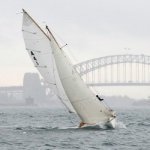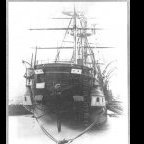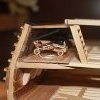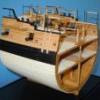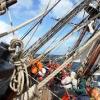MORE HANDBOOKS ARE ON THEIR WAY! We will let you know when they get here.
×
-
Posts
801 -
Joined
-
Last visited
Reputation Activity
-
 Mark Pearse got a reaction from Jack12477 in Ranger type yacht by Mark Pearse - 1:12 - SMALL
Mark Pearse got a reaction from Jack12477 in Ranger type yacht by Mark Pearse - 1:12 - SMALL
I'm planning the metalwork & ....!!!! the smaller sizes of brass flat bar don't seem to be available.
6mm (1/4") width seems to be the minimum width - but a mere 5 years ago the range was much greater. It's kind of shocking.
any suggestions?
-
 Mark Pearse reacted to Bedford in Tally Ho by vaddoc - scale 1:12 (maybe) - as rebuilt by Leo
Mark Pearse reacted to Bedford in Tally Ho by vaddoc - scale 1:12 (maybe) - as rebuilt by Leo
Vaddock, I was wondering what you're up to and now I know.
I've watched several of Leos videos too. He really knows his craft doesn't he.
Funnily enough, as a builder of full sized sailing boats, I get lost in all the discussion about lines and often wonder just how important all those calculations are but I guess they must be because people use them.
So I'll just sit quietly on the sidelines until you start making sawdust
-
 Mark Pearse reacted to druxey in Tally Ho by vaddoc - scale 1:12 (maybe) - as rebuilt by Leo
Mark Pearse reacted to druxey in Tally Ho by vaddoc - scale 1:12 (maybe) - as rebuilt by Leo
A really good step forward!
-
 Mark Pearse got a reaction from Keith Black in Tally Ho by vaddoc - scale 1:12 (maybe) - as rebuilt by Leo
Mark Pearse got a reaction from Keith Black in Tally Ho by vaddoc - scale 1:12 (maybe) - as rebuilt by Leo
that's great, well done indeed
-
 Mark Pearse got a reaction from druxey in Tally Ho by vaddoc - scale 1:12 (maybe) - as rebuilt by Leo
Mark Pearse got a reaction from druxey in Tally Ho by vaddoc - scale 1:12 (maybe) - as rebuilt by Leo
that's great, well done indeed
-
 Mark Pearse reacted to vaddoc in Tally Ho by vaddoc - scale 1:12 (maybe) - as rebuilt by Leo
Mark Pearse reacted to vaddoc in Tally Ho by vaddoc - scale 1:12 (maybe) - as rebuilt by Leo
Dear all
I think I did it!
But first my deepest thank you to all that visited, hit the like button or replied - much appreciated!
How right you all are:
Now David, I had forgotten all about the diagonals! Silly as my first efforts to loft the boat were actually using the diagonals, which is what Leo did. Thanks! Diagonals coming up bellow.
I did exactly this Mark! Still, this led to a stem just short of 9 inches wide, whereas Leo ended up with a 7 inch stem. No matter how much I tried I could not match this without drastically altering the shape of the sheer or having a stem clearly wrong and too far off the plans.
Absolutely. After the hull was pretty much shaped, I realised that what appeared as large unfairness in the CAD lines was in reality just a difference of 3-4 mm, and this in the full size boat.
I most certainly will Greg and I also plan to visit Tally Ho (if possible) when Leo gets back home. All in good time!
Ok, so now let me share the progress made - I must admit I am pretty happy, unless some eagled eyed people find a huge error somewhere!
So blending all data sources I found a happy medium for the sheer, the stem, the sternpost, transom, face of stem and keel. I accepted that frame no 2 will be a bit S-shaped (not much). I then went through three lofting cycles. Suddenly, all fell into place! All lines were fair and the frames and waterlines were either touching or just a few mm apart:
These are the sets of frames after each cycle - the white frames are the traced ones from Mr Strange's drawings.
But is the hull really fair? Enter diagonals!
It is actually ok!
The unfairness at the stern is because I used the last frame to create the lines - without it the top three diagonals become completely fair. I will actually not be using this last frame so all good. The bottom diagonal is a bit wonky but the distance to fairness in that aft point in reality is just 2 mm in the full scale boat - meaningless.
At the bow, again the adjustments to make the diagonals fair are tiny.
In any case, I thought I d give it a try. So I faired the diagonals...
......produced the new contact points with the frames and transferred these points over to the finished hull to redraw these frames...
....and then I gave up. It was meaningless, the difference was just a few mm. In the actual boat it would not make a difference, even Leo accepted 1/8 inch tolerance. In 1/12 scale, this tolerance becomes less than 0.5mm.
The next photo shows my frames compared the the traced ones - they are pretty close.
So lets see the hull!
Now, this looks pretty fair. More bellow
Adding the rest of rabet at the stern
And a couple of photos of the complete hull.
I think it is adequate to start the project and the wood will correct any imperfections.
This was the first of I am sure many milestones in this very long journey. We are still far from making any wood dust.
Take care all
Vaddoc
-
 Mark Pearse got a reaction from KennyH78 in Tally Ho by vaddoc - scale 1:12 (maybe) - as rebuilt by Leo
Mark Pearse got a reaction from KennyH78 in Tally Ho by vaddoc - scale 1:12 (maybe) - as rebuilt by Leo
Hi Vaddoc
If there's a conflict in the information, the approach I take is to work out which aspect of the information to give priority to & which one to adjust. In the case of a conflict between the hull shape & the profile of the stem, I would likely prioritise the hull shape & allow the stem profile to adjust. (The stem profile will still be close, as unless there's an error the amount of adjustment should be minor). I encourage you to be decisive on this sort of choice....what would a boat builder do....?
I would add that in some respects CAD is a double-edged sword. Its precision can make it look like the situation is worse than it really is. If we were still working with pencils, a lot of conflicts would be within the thickness of a line, or within the manual tolerances of draughting.
-
 Mark Pearse got a reaction from dvm27 in Tally Ho by vaddoc - scale 1:12 (maybe) - as rebuilt by Leo
Mark Pearse got a reaction from dvm27 in Tally Ho by vaddoc - scale 1:12 (maybe) - as rebuilt by Leo
Hi Vaddoc
If there's a conflict in the information, the approach I take is to work out which aspect of the information to give priority to & which one to adjust. In the case of a conflict between the hull shape & the profile of the stem, I would likely prioritise the hull shape & allow the stem profile to adjust. (The stem profile will still be close, as unless there's an error the amount of adjustment should be minor). I encourage you to be decisive on this sort of choice....what would a boat builder do....?
I would add that in some respects CAD is a double-edged sword. Its precision can make it look like the situation is worse than it really is. If we were still working with pencils, a lot of conflicts would be within the thickness of a line, or within the manual tolerances of draughting.
-
 Mark Pearse got a reaction from druxey in Tally Ho by vaddoc - scale 1:12 (maybe) - as rebuilt by Leo
Mark Pearse got a reaction from druxey in Tally Ho by vaddoc - scale 1:12 (maybe) - as rebuilt by Leo
Hi Vaddoc
If there's a conflict in the information, the approach I take is to work out which aspect of the information to give priority to & which one to adjust. In the case of a conflict between the hull shape & the profile of the stem, I would likely prioritise the hull shape & allow the stem profile to adjust. (The stem profile will still be close, as unless there's an error the amount of adjustment should be minor). I encourage you to be decisive on this sort of choice....what would a boat builder do....?
I would add that in some respects CAD is a double-edged sword. Its precision can make it look like the situation is worse than it really is. If we were still working with pencils, a lot of conflicts would be within the thickness of a line, or within the manual tolerances of draughting.
-
 Mark Pearse got a reaction from Keith Black in Tally Ho by vaddoc - scale 1:12 (maybe) - as rebuilt by Leo
Mark Pearse got a reaction from Keith Black in Tally Ho by vaddoc - scale 1:12 (maybe) - as rebuilt by Leo
Hi Vaddoc
If there's a conflict in the information, the approach I take is to work out which aspect of the information to give priority to & which one to adjust. In the case of a conflict between the hull shape & the profile of the stem, I would likely prioritise the hull shape & allow the stem profile to adjust. (The stem profile will still be close, as unless there's an error the amount of adjustment should be minor). I encourage you to be decisive on this sort of choice....what would a boat builder do....?
I would add that in some respects CAD is a double-edged sword. Its precision can make it look like the situation is worse than it really is. If we were still working with pencils, a lot of conflicts would be within the thickness of a line, or within the manual tolerances of draughting.
-
 Mark Pearse reacted to wefalck in Pomeranian Rahschlup 1846 by wefalck – 1/160 scale – single-masted Baltic trading vessel
Mark Pearse reacted to wefalck in Pomeranian Rahschlup 1846 by wefalck – 1/160 scale – single-masted Baltic trading vessel
Work was been interrupted again, this time by some business travel to Tallinn for a few days, where I had also the opportunity to visit the Estonian Maritime Museum. Unfortunately, I came back from there with a sort of bronchitis that bogged me down for a couple of weeks ...
Pin-rails
Another delay in actual shop-work was caused that I first had to work out were the pin-rails would go and how many pins they have to have to provide the necessary belaying points.
Drilling the pin-rails using the micro-mill as a coordinate drilling machine
The pin-rails are 2.2 mm wide strips cut from 0.8 mm thick acrylic sheet. The holes were drilled using the micro-milling machine as a coordinate drill to get the distances right. The outer edges of the pin-rails were rounded as can be seen on many prototype photographs. The inner edges were notched for the bulwark stanchions on the filing-machine.
Cutting the notches for the stanchions on the filing-machine
Cutting the notches for the stanchions on the filing-machine
Collection of pin-rails
Pin-rails loosely attached at their designated location
To be continued …
-
 Mark Pearse got a reaction from MAGIC's Craig in Ranger type yacht by Mark Pearse - 1:12 - SMALL
Mark Pearse got a reaction from MAGIC's Craig in Ranger type yacht by Mark Pearse - 1:12 - SMALL
One detail that had been bothering me was the winches I purchased, for the running backstays & the mast halyards - nice but technically not very good. Steve from this forum (Bedford) kindly offered to assist & turned up some flanges perfectly to size, the difference is wonderful. They will be soldered together & tinned (thank you Welfack)
the winches before:
and after (now that's a winch):
happy days....
-
 Mark Pearse reacted to Baker in Große Jacht 1679 by Baker - Corel - 1:50 - modified model from the Yacht D'Oro kit
Mark Pearse reacted to Baker in Große Jacht 1679 by Baker - Corel - 1:50 - modified model from the Yacht D'Oro kit
Cannon production
Step 1: prototype
Step 2: carriages painted and barrels in place
Step3: ready for last painting
Step 3 ready
I didn't like the first method of planking in this area.
So I cut the 2mm planks from the kit to 1mm. And planked again.
-
 Mark Pearse got a reaction from yvesvidal in Ranger type yacht by Mark Pearse - 1:12 - SMALL
Mark Pearse got a reaction from yvesvidal in Ranger type yacht by Mark Pearse - 1:12 - SMALL
One detail that had been bothering me was the winches I purchased, for the running backstays & the mast halyards - nice but technically not very good. Steve from this forum (Bedford) kindly offered to assist & turned up some flanges perfectly to size, the difference is wonderful. They will be soldered together & tinned (thank you Welfack)
the winches before:
and after (now that's a winch):
happy days....
-
 Mark Pearse reacted to Bedford in Ranger type yacht by Mark Pearse - 1:12 - SMALL
Mark Pearse reacted to Bedford in Ranger type yacht by Mark Pearse - 1:12 - SMALL
Happy to help Mark, and yes they look much better with than without
-
 Mark Pearse got a reaction from Bedford in Ranger type yacht by Mark Pearse - 1:12 - SMALL
Mark Pearse got a reaction from Bedford in Ranger type yacht by Mark Pearse - 1:12 - SMALL
One detail that had been bothering me was the winches I purchased, for the running backstays & the mast halyards - nice but technically not very good. Steve from this forum (Bedford) kindly offered to assist & turned up some flanges perfectly to size, the difference is wonderful. They will be soldered together & tinned (thank you Welfack)
the winches before:
and after (now that's a winch):
happy days....
-
 Mark Pearse reacted to Baker in Große Jacht 1679 by Baker - Corel - 1:50 - modified model from the Yacht D'Oro kit
Mark Pearse reacted to Baker in Große Jacht 1679 by Baker - Corel - 1:50 - modified model from the Yacht D'Oro kit
There is indeed no support on the rear side.
A brand new replica leeboard on the rear side.
And years later during a maintenance, you see also no supports on the port side leeboard.
It is possible that the separate pieces were held together with one or more long bolts, don't now.
-
 Mark Pearse reacted to Jim Lad in Ranger type yacht by Mark Pearse - 1:12 - SMALL
Mark Pearse reacted to Jim Lad in Ranger type yacht by Mark Pearse - 1:12 - SMALL
They look good with those flanges, Mark!
John
-
 Mark Pearse got a reaction from wefalck in Ranger type yacht by Mark Pearse - 1:12 - SMALL
Mark Pearse got a reaction from wefalck in Ranger type yacht by Mark Pearse - 1:12 - SMALL
One detail that had been bothering me was the winches I purchased, for the running backstays & the mast halyards - nice but technically not very good. Steve from this forum (Bedford) kindly offered to assist & turned up some flanges perfectly to size, the difference is wonderful. They will be soldered together & tinned (thank you Welfack)
the winches before:
and after (now that's a winch):
happy days....
-
 Mark Pearse got a reaction from JacquesCousteau in Ranger type yacht by Mark Pearse - 1:12 - SMALL
Mark Pearse got a reaction from JacquesCousteau in Ranger type yacht by Mark Pearse - 1:12 - SMALL
One detail that had been bothering me was the winches I purchased, for the running backstays & the mast halyards - nice but technically not very good. Steve from this forum (Bedford) kindly offered to assist & turned up some flanges perfectly to size, the difference is wonderful. They will be soldered together & tinned (thank you Welfack)
the winches before:
and after (now that's a winch):
happy days....
-
 Mark Pearse got a reaction from Jack12477 in Ranger type yacht by Mark Pearse - 1:12 - SMALL
Mark Pearse got a reaction from Jack12477 in Ranger type yacht by Mark Pearse - 1:12 - SMALL
One detail that had been bothering me was the winches I purchased, for the running backstays & the mast halyards - nice but technically not very good. Steve from this forum (Bedford) kindly offered to assist & turned up some flanges perfectly to size, the difference is wonderful. They will be soldered together & tinned (thank you Welfack)
the winches before:
and after (now that's a winch):
happy days....
-
 Mark Pearse got a reaction from cotrecerf in Ranger type yacht by Mark Pearse - 1:12 - SMALL
Mark Pearse got a reaction from cotrecerf in Ranger type yacht by Mark Pearse - 1:12 - SMALL
One detail that had been bothering me was the winches I purchased, for the running backstays & the mast halyards - nice but technically not very good. Steve from this forum (Bedford) kindly offered to assist & turned up some flanges perfectly to size, the difference is wonderful. They will be soldered together & tinned (thank you Welfack)
the winches before:
and after (now that's a winch):
happy days....
-
 Mark Pearse got a reaction from cotrecerf in Ranger type yacht by Mark Pearse - 1:12 - SMALL
Mark Pearse got a reaction from cotrecerf in Ranger type yacht by Mark Pearse - 1:12 - SMALL
Some more details on the boil:
The tiller is underway, & either finished or nearly there. Possibly another coat or two of shellac, the actual tiller is an aged piece of hardwood, so would be good to give it some of that character.
The bowsprit & spinnaker pole are underway, here they are tapered & cut to length:
I will do the pole, including end fittings primarily in timber. The actual pole is unfinished carbon fibre , so satin black, & the ends unfinished cast alloy of some sort. The basic details of the end fittings are roughed out, & since the photos the ends were treated with some CA glue to harden the timber & avoid splitting when cutting the beaks. To replicate carbon fibre, I rubbed the pole with black paint, with no undercoat. It's looking ok, so a gentle sand & another coat might do the trick. To help articulate the joint at the end fittings of the pole, I did a groove by rolling the pole under the blade of a craft knife, they have a nice straight long blade.
-
 Mark Pearse got a reaction from cotrecerf in Ranger type yacht by Mark Pearse - 1:12 - SMALL
Mark Pearse got a reaction from cotrecerf in Ranger type yacht by Mark Pearse - 1:12 - SMALL
Thank you Steve & welcome Welfack, & hi to everyone -
I've now almost completed the timber work, & apart from the spars just the tiller remains to be done now. Then I'll work on the spars & metalwork. This boat has stainless steel fittings, so I'll be painting the metalwork silver. This recent work includes deck & cockpit timber details, all unfinished (weathered) teak.
The bases for the cockpit winches, which are used mainly for the running backstays.
The deck cutwaters, deck winch bases & a small base for a cam cleat fitting - that are all alongside the main hatch. And the large cutaway on the port side cutwater is a support for the spinnaker pole.
The Sampson post & the forwards support chock for the spinnaker pole. The sampson post isn't fixed down yet, there will be a mortise for the bowsprit, to be cut into the forward side face.
And the port side cutwater. The small holes are for the lines that lead to the cam cleats: spinnaker topping lift one side & spinnaker pole kicker the other. I'm not sure what the 3rd one is, but will find out.
They were tricky to drill due to the angles & the fact that regular drill bits down't work well at angles, especially if it's a small hand drill. What I did was: to initially drill the holes & then put CA glue on it all to harden the timber up, drill right through & CA to the hole...then when hard clean it all up. I also found that a 1mm wide strip of sandpaper was quite a useful way to sand inside the angled holes.
thanks,
-
 Mark Pearse got a reaction from cotrecerf in Ranger type yacht by Mark Pearse - 1:12 - SMALL
Mark Pearse got a reaction from cotrecerf in Ranger type yacht by Mark Pearse - 1:12 - SMALL
Thank you everyone,
I'm now back from a Nordic trip in the northern hemisphere summer, & have now finished & assembled more of the details around the cockpit & face of the raised deck. The horizontal varnished trimming pieces both sides of the companionway, which insect with a vertical varnished piece each side; & the weathered teak cockpit seat backrests.
Overall view:
Detail, & I can see the pencil alignment mark needs to be removed:
The junction of the strips was difficult to get, but happy with this:
Detail, showing the drain openings & another pencil mark to be removed...
Trimming piece, against the deck.
thanks for looking in,


